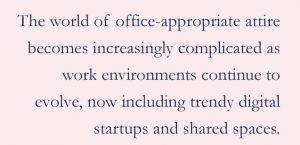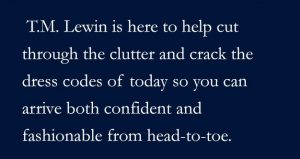Dressing for success
 While workplace dress codes may differ by industry, their impact bears equal influence in almost any given work environment, especially in a professional or corporate setting. Learning your own corporate culture is a must, as is understanding the type of outward presentation which best compliments your role and standing within the organization.
While workplace dress codes may differ by industry, their impact bears equal influence in almost any given work environment, especially in a professional or corporate setting. Learning your own corporate culture is a must, as is understanding the type of outward presentation which best compliments your role and standing within the organization.
While some companies opt for casual dress, others rely on a more corporate dress code to maintain their professional image with clients, prospects, and business partners. Basic business protocol is often associated with conservative business attire, and an individual who looks the part often creates an even greater opportunity to prove themselves as a competent associate.
Why it matters
As stated by Darlene Price, author of “Well Said! Presentations and Conversations that Get Results” and president of Well Said, Inc., “…in the big picture of ultimate reality, what you wear neither defines who you are as a person, nor determines your value as a human being”. However, she continues, “…fair or not, people judge us by the way we look and that includes the way we dress”. She adds that this is particularly true in the workplace, where your attire has a significant impact upon how others perceive and behave toward you.While there is sometimes a grey area surrounding the idea of whether certain companies can actually enforce or impose a specific dress code upon its work staff, employees should remember that the way they dress not only conveys a certain message about the company as a whole, but about the individual as well. A talented worker who dresses with an executive’s style is indicating readiness for what is possibly next in his or her career.

Luckily, in addition to assessing the wardrobe choices of your co-workers and superiors, some simple web surfing can provide you with ideas as to what types of quality garment choices, such as these at T.M. Lewin, work best for you personally.
Not necessarily casual
There are businesses who have selected a more casual tone for their offices, veering away from traditional business attire. Others may maintain a corporate dress code, but still allow employees to participate in “casual Friday”. However, employees must be cognizant of the difference between casual work attire and casual everyday attire; hence the term, “business casual”, which most commonly does not include jeans and T-shirts.
This article at moneycrashers.com, “What to Wear to Work – Tips for 4 Types of Office Dress Code Policies” offers helpful specifics on the most appropriate wardrobe choices for professional men and women.
In closing
 Interpreting a company’s dress code may take some time and effort, especially if they oscillate between corporate and casual. The best advice is, when in doubt, dress ever so slightly more professional than you think you should. It’s always easier to tone down afterward, if you do feel you are somewhat overdressed, than to reestablish your outward image as a competent, professional employee among a group of coworkers dressed in business suits.
Interpreting a company’s dress code may take some time and effort, especially if they oscillate between corporate and casual. The best advice is, when in doubt, dress ever so slightly more professional than you think you should. It’s always easier to tone down afterward, if you do feel you are somewhat overdressed, than to reestablish your outward image as a competent, professional employee among a group of coworkers dressed in business suits.